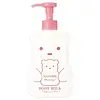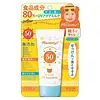What's inside
What's inside
 Key Ingredients
Key Ingredients

 Benefits
Benefits

 Concerns
Concerns

 Ingredients Side-by-side
Ingredients Side-by-side

Water
Skin ConditioningPropylene Glycol
HumectantGlycerin
HumectantMacadamia Ternifolia Seed Oil
EmollientTrehalose
HumectantSimmondsia Chinensis Seed Oil
EmollientAloe Barbadensis Leaf Juice
Skin ConditioningSodium Hyaluronate
HumectantGlucosyl Ceramide
Skin ConditioningCetearyl Alcohol
EmollientPolyglyceryl-10 Stearate
Skin ConditioningSimethicone
EmollientGlyceryl Stearate
EmollientXanthan Gum
EmulsifyingSorbitan Stearate
EmulsifyingPolyglyceryl-10 Oleate
Skin ConditioningTocopherol
AntioxidantCellulose Gum
Emulsion StabilisingMaltodextrin
AbsorbentBeta-Glucan
Skin ConditioningWater, Propylene Glycol, Glycerin, Macadamia Ternifolia Seed Oil, Trehalose, Simmondsia Chinensis Seed Oil, Aloe Barbadensis Leaf Juice, Sodium Hyaluronate, Glucosyl Ceramide, Cetearyl Alcohol, Polyglyceryl-10 Stearate, Simethicone, Glyceryl Stearate, Xanthan Gum, Sorbitan Stearate, Polyglyceryl-10 Oleate, Tocopherol, Cellulose Gum, Maltodextrin, Beta-Glucan
Water
Skin ConditioningPropylene Glycol
HumectantEthylhexyl Methoxycinnamate
UV AbsorberDiethylamino Hydroxybenzoyl Hexyl Benzoate
UV FilterPentylene Glycol
Skin ConditioningSodium Hyaluronate
HumectantSimmondsia Chinensis Seed Oil
EmollientGlucosyl Ceramide
Skin ConditioningMalpighia Emarginata Fruit Extract
Skin ConditioningHydrolyzed Collagen
EmollientAloe Barbadensis Leaf Extract
EmollientRubus Idaeus Extract
Skin ProtectingBis-Ethylhexyloxyphenol Methoxyphenyl Triazine
Skin ConditioningDiphenylsiloxy Phenyl Trimethicone
Skin ConditioningIsononyl Isononanoate
EmollientPPG-7/PEG-30 Phytosterol
EmulsifyingPEG-30 Phytosterol
EmulsifyingPEG-10 Hydrogenated Castor Oil
EmollientEthylhexylglycerin
Skin ConditioningDimethicone/Phenyl Vinyl Dimethicone Crosspolymer
Alpha-Glucan Oligosaccharide
CleansingBetaine
HumectantAcrylates/C10-30 Alkyl Acrylate Crosspolymer
Emulsion StabilisingCarbomer
Emulsion StabilisingPotassium Hydroxide
BufferingXanthan Gum
EmulsifyingHydroxypropyl Methylcellulose Stearoxy Ether
Acrylates/Steareth-20 Itaconate Copolymer
PEG-5 Phytosterol
EmulsifyingDisodium EDTA
Butylene Glycol
HumectantBHT
AntioxidantDextrin
AbsorbentWater, Propylene Glycol, Ethylhexyl Methoxycinnamate, Diethylamino Hydroxybenzoyl Hexyl Benzoate, Pentylene Glycol, Sodium Hyaluronate, Simmondsia Chinensis Seed Oil, Glucosyl Ceramide, Malpighia Emarginata Fruit Extract, Hydrolyzed Collagen, Aloe Barbadensis Leaf Extract, Rubus Idaeus Extract, Bis-Ethylhexyloxyphenol Methoxyphenyl Triazine, Diphenylsiloxy Phenyl Trimethicone, Isononyl Isononanoate, PPG-7/PEG-30 Phytosterol, PEG-30 Phytosterol, PEG-10 Hydrogenated Castor Oil, Ethylhexylglycerin, Dimethicone/Phenyl Vinyl Dimethicone Crosspolymer, Alpha-Glucan Oligosaccharide, Betaine, Acrylates/C10-30 Alkyl Acrylate Crosspolymer, Carbomer, Potassium Hydroxide, Xanthan Gum, Hydroxypropyl Methylcellulose Stearoxy Ether, Acrylates/Steareth-20 Itaconate Copolymer, PEG-5 Phytosterol, Disodium EDTA, Butylene Glycol, BHT, Dextrin
 Reviews
Reviews

Ingredients Explained
These ingredients are found in both products.
Ingredients higher up in an ingredient list are typically present in a larger amount.
Glucosyl Ceramide is made from glucose and a ceramide. It has skin hydrating and barrier repair properties.
This ingredient is naturally found in the epidermis, or upper layers of skin, as the main glycosphingolipid. Glycosphingolipids play a role in maintaining a strong and hydrated skin barrier.
Fun fact: Consuming glucosyl ceramide has been shown to provide skin benefits. You can get your intake by eating wheat, corn, soybeans, and shiitake mushrooms.
Learn more about Glucosyl CeramidePropylene Glycol is an odorless, colorless liquid. As a humectant, it helps skin retain moisture. It also aids in delivering active ingredients.
Another role of this ingredient is preventing a product from melting or freezing. Propylene glycol also adds antimicrobrial properties to a product, elongating product lifespan.
This ingredient is considered an organic alcohol and commonly added into both cosmetics and foods.
Those with sensitive skin or conditions may develop a rash when using this ingredient.
Learn more about Propylene GlycolThis oil comes from the seeds of the desert shrub called Jojoba. It is more commonly known as jojoba oil, a non-comedogenic oil.
Jojoba oil does not contain fragrance and has many fatty-acids, making it a great soothing ingredient.
It also contains Vitamin E, a great moisturizing ingredient. Vitamin E is also an antioxidant and protects your skin against oxidative damage.
This ingredient humectant properties, meaning it helps draw moisture from the air. This helps keep your skin hydrated.
While jojoba has antibacterial properties, it is only able to kill some strains of bacteria.
Studies also show it helps in wound healing. In fact, Indigenous cultures have used jojoba as a moisturizer and to help treat burns for centuries.
Fun fact: Jojoba oil similar to natural human skin sebum, so it has a great effect on dry skin. It is also promising with helping to regulate sebum production.
Due to its fatty acid content, Jojoba oil may not be fungal acne safe. We recommend speaking with a professional if you have any concerns.
Learn more about Simmondsia Chinensis Seed OilSodium Hyaluronate is hyaluronic acid's salt form. It is commonly derived from the sodium salt of hyaluronic acid.
Like hyaluronic acid, it is great at holding water and acts as a humectant. This makes it a great skin hydrating ingredient.
Sodium Hyaluronate is naturally occurring in our bodies and is mostly found in eye fluid and joints.
These are some other common types of Hyaluronic Acid:
Learn more about Sodium HyaluronateWater. It's the most common cosmetic ingredient of all. You'll usually see it at the top of ingredient lists, meaning that it makes up the largest part of the product.
So why is it so popular? Water most often acts as a solvent - this means that it helps dissolve other ingredients into the formulation.
You'll also recognize water as that liquid we all need to stay alive. If you see this, drink a glass of water. Stay hydrated!
Learn more about WaterXanthan gum is used as a stabilizer and thickener within cosmetic products. It helps give products a sticky, thick feeling - preventing them from being too runny.
On the technical side of things, xanthan gum is a polysaccharide - a combination consisting of multiple sugar molecules bonded together.
Xanthan gum is a pretty common and great ingredient. It is a natural, non-toxic, non-irritating ingredient that is also commonly used in food products.
Learn more about Xanthan Gum